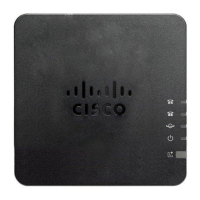DescriptionField
Interval for sending out RTCP sender reports on an
active connection. It can range from 0 to 255 seconds.
During an active connection, the ATA can be
programmed to send out compound RTCP packet on
the connection. Each compound RTP packet except
the last one contains a SR (Sender Report) and a
SDES (Source Description). The last RTCP packet
contains an extra BYE packet. Each SR except the
last one contains exactly 1 RR (Receiver Report); the
last SR carries no RR. The SDES contains CNAME,
NAME, and TOOL identifiers. The CNAME is set
to <User ID>@<Proxy>, NAME is set to <Display
Name> (or Anonymous if user blocks caller ID), and
TOOL is set to the
Vendor/Hardware-platform-software-version. The
NTP timestamp used in the SR is a snapshot of the
local time for the ATA, not the time reported by an
NTP server. If the ATA receives a RR from the peer,
it attempts to compute the round-trip delay and show
it as the Call Round Trip Delay value (ms) on the
Information page.
Default setting: 0
RTCP Tx Interval
Select yes if you want the ATA to calculate the UDP
header checksum for SIP messages. Otherwise, select
no.
Default setting: no
No UDP Checksum
Determines whether the ATA includes the P-RTP-Stat
header or response in a BYE message. The header
contains the RTP statistics of the current call. Select
yes or no from the drop-down list.
Default setting: yes
The format of the P-RTP-Stat header is:
P-RTP-State: PS=<packets sent>,OS=<octets
sent>,PR=<packets received>,OR=<octets
received>,PL=<packets lost>,JI=<jitter in
ms>,LA=<delay in ms>,DU=<call duration
ins>,EN=<encoder>,DE=<decoder>.
Stats In BYE
Cisco ATA 191 and ATA 192 Analog Telephone Adapter Administration Guide for Multiplatform Firmware
44
Voice Settings Configuration
RTP Parameters

